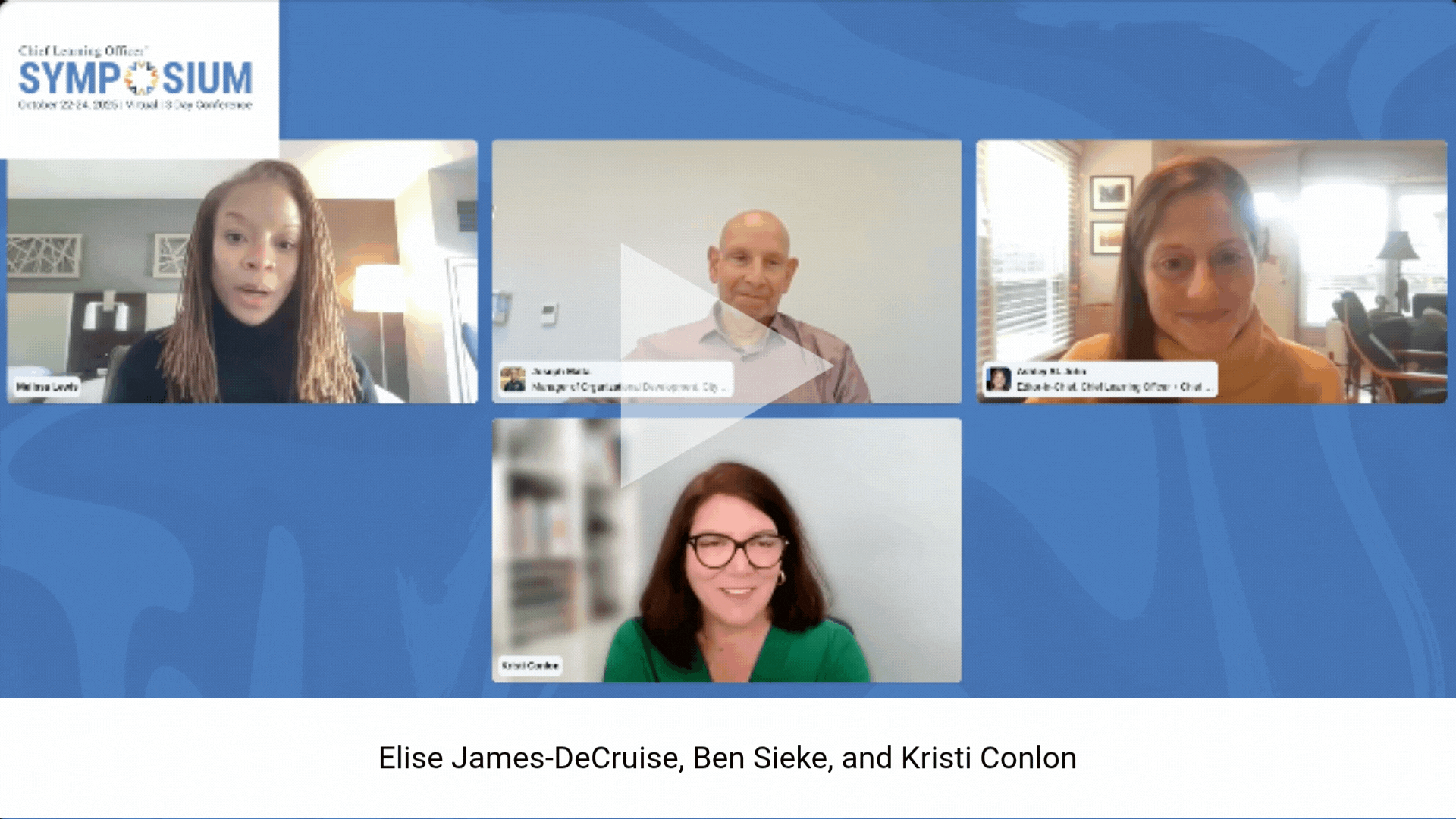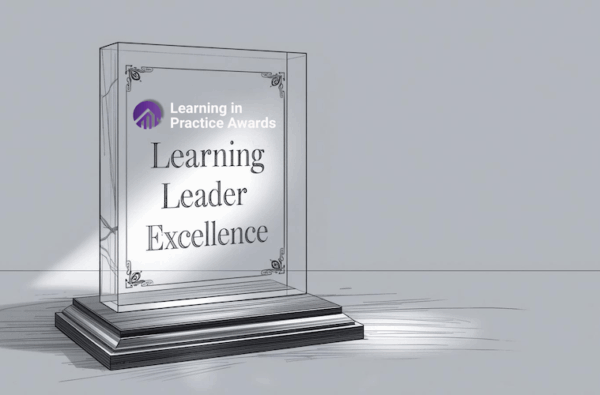As someone with a background in cognitive science, I’ve always been fascinated by how people think, learn and adapt.
That’s why I often ask people, “How does your brain work? How do you approach issues and solve problems?” The most common response I get is, “I don’t really know how my brain works.” Some people even joke and say, “My brain doesn’t work all that well!”
So then I follow up with the question, “How were you taught to learn?” and the answer is usually, “I wasn’t really taught how to learn, it just sort of happened.” Occasionally, someone will say, “I learned by osmosis.”
It’s clear most people aren’t consciously aware of their thinking process when it comes to problem-solving. Nor have they been taught how to optimize their learning abilities, which can lead to wildly varying results, even when the training materials and delivery methods are the same.
Why is this the case, and what can we do about it? In this age of digital disruption, it’s especially important to take a closer look at how we learn and prepare our leaders and teams for the challenges ahead.
Why digital/AI disruption will require innovative and new L&D strategies
The rapid advancement of digital disruption and the recent widespread implementation of AI have propelled us into the early stages of the Fourth Industrial Revolution, according to the World Economic Forum. In WEF’s “2020 Future of Jobs Report,” it is suggested that 50 percent of all employees will require reskilling by 2025 and that a billion people will need to be reskilled by 2030.
The 2025 skills outlined in the WEF Report emphasize thinking and self-management skills, rather than traditional knowledge-based subject matter expertise.
Additionally, new brain science is challenging old approaches to learning and development. As a result, addressing the WEF’s reskilling revolution successfully will require more than just providing new content and using new delivery mechanisms. It will involve understanding how people learn best and how organizations can enhance their employees’ learning agility to equip them with the skills needed to become lifelong learners and be more adaptable. This will necessitate an innovative approach to L&D strategy with an emphasis on thinking skills and adaptability, thereby enabling employees and organizations to thrive in the age of the reskilling revolution.
It will also entail the chief learning officer engaging in some critical discussions and negotiations with their CEO and CFO.
CLOs will be required to lead the charge in this reskilling revolution, ensuring their organizations remain competitive and sustainable. An effective reskilling strategy and execution will provide a competitive advantage, while getting it wrong may result in organizations becoming unviable.
Therefore, this is a significant strategic issue for organizations that requires a collaborative and integrated approach by:
- The CEO, to make sure that addressing the reskilling revolution is a key priority in the overall organizational strategy.
- The CFO, to make sure that the reskilling strategy is appropriately and fully funded.
- The CLO, to design and implement an effective and innovative reskilling strategy that can address this novel problem/opportunity, and ensure that the program is well-resourced and funded with the strong backing of the CEO and CFO.
Leveraging brain science to enhance L&D strategies
Have you ever noticed that, even after attending the same training program on the same day with the same facilitator, two people can have vastly different levels of comprehension and learning? This is due to the differing levels of cognitive and agile learning (learning to learn) capabilities.
Let’s delve into cognitive science and neuroscience research to better understand how the brain learns and applies new knowledge. By doing so, we can prepare ourselves to develop innovative L&D strategies that address the WEF reskilling revolution issues.
Part one: Cognitive science, CHC theory of human cognitive abilities
Think of the brain as an iceberg, with the conscious mind above the waterline and the subconscious brain below. The Cattell-Horn-Carroll Theory of Human Cognitive Abilities is a model that analyses the cognitive abilities that impact an individual’s learning ability.
To make CHC theory more understandable and intuitive, I’ve slightly adapted some of its terms:
Crystallized knowledge. This is the knowledge an individual has accumulated over their lifetime. It’s what we know. It is language-based and two of its key components are:
- Declarative knowledge: Knowledge that can be declared to demonstrate understanding, such as understanding a particular marketing model.
- Procedural knowledge: Knowledge of procedures or operations, such as knowing how to create a formula in Excel.
From an L&D perspective, language-based approaches like facilitated training, coaching, books and online courses provide the input mechanism. The output mechanism assesses what a person has comprehended using language-based feedback such as verbal responses, essays, multiple-choice questions, online tests, etc. However, this approach only assesses comprehension, not the ability to apply newly acquired knowledge.
Fluid thinking. This is the raw cognitive capability that enables flexible and agile thinking, providing the ability to adapt quickly to new and novel problems, opportunities and disruptions. It’s how we think and process information.
It supports effective and efficient learning, and the ready application of newly acquired knowledge — agile learning if you will. It’s underpinned by 10 subconscious thinking habits (or “mini-brain computing programs”), such as analytical thinking, innovative thinking, conceptual thinking, strategic thinking, abstract thinking, etc. fluid thinking is also what we use to address VUCA situations.
From an L&D perspective, enhancing these subconscious thinking habits involves using Ericsson’s deliberate practice approach. Under the guidance of an expert, it consists of repeated practice of harder and harder cognitive tasks over time, and tapping into the brain’s inherent neuroplasticity. This process strengthens the associated neural pathways so that they can run automatically and without conscious thought. In this way, they become part of the brain’s “subconscious operating system.”
A distinguishing feature of fluid thinking is the capacity to solve new and novel problems without prior knowledge or strategies to guide the development of the solution. This capability will be paramount in the age of digital disruption. In the context of a computer analogy, fluid thinking is akin to a computer’s operating system that runs in the background, below your conscious awareness. However, you become very aware of it when it runs slowly or freezes at an inopportune time, such as during an important presentation.
Let’s use an analogy to compare crystallized knowledge and fluid thinking capability. A non-swimmer can read a book on how to swim and fully comprehend the subject, yet they could jump into the surf and still drown because they don’t know how to apply their new knowledge.
Figure 1 summarizes the differences between crystallized knowledge and fluid thinking.
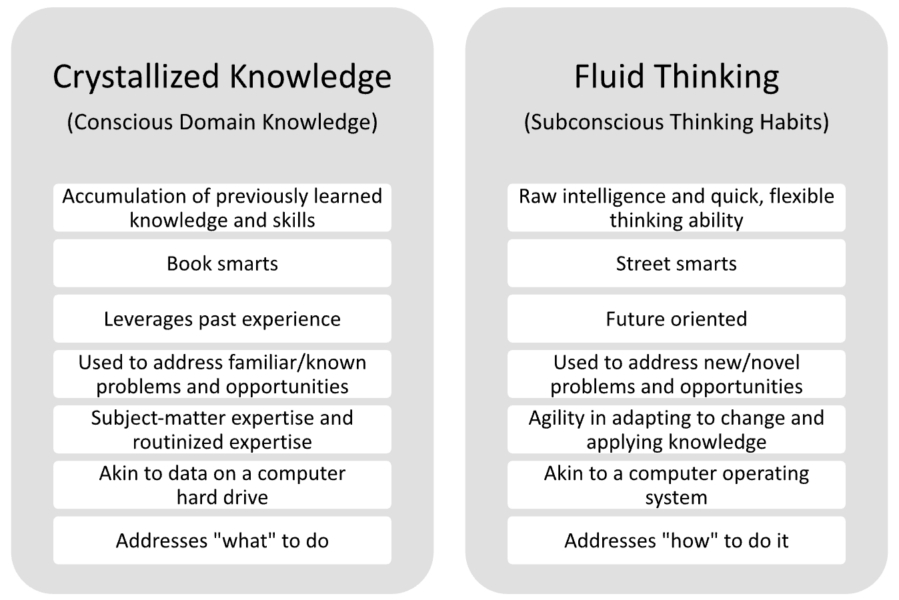
What are the top 10 skills from the Future of Jobs Report by WEF?
The WEF Future of Jobs Report highlights the top 10 skills that businesses will require by 2025. Interestingly, only 20 percent of these skills are related to crystallized knowledge.
However, 80 percent of these skills are underpinned by, or related to, fluid thinking and the associated 10 subconscious thinking habits. This makes it clear where the WEF report sees the skills emphasis related to the reskilling revolution.
The skills identified by the WEF are listed in the table shown in Figure 2. To illustrate the difference, the skills have been further categorized into the cognitive territories of fluid thinking and crystallized Knowledge.
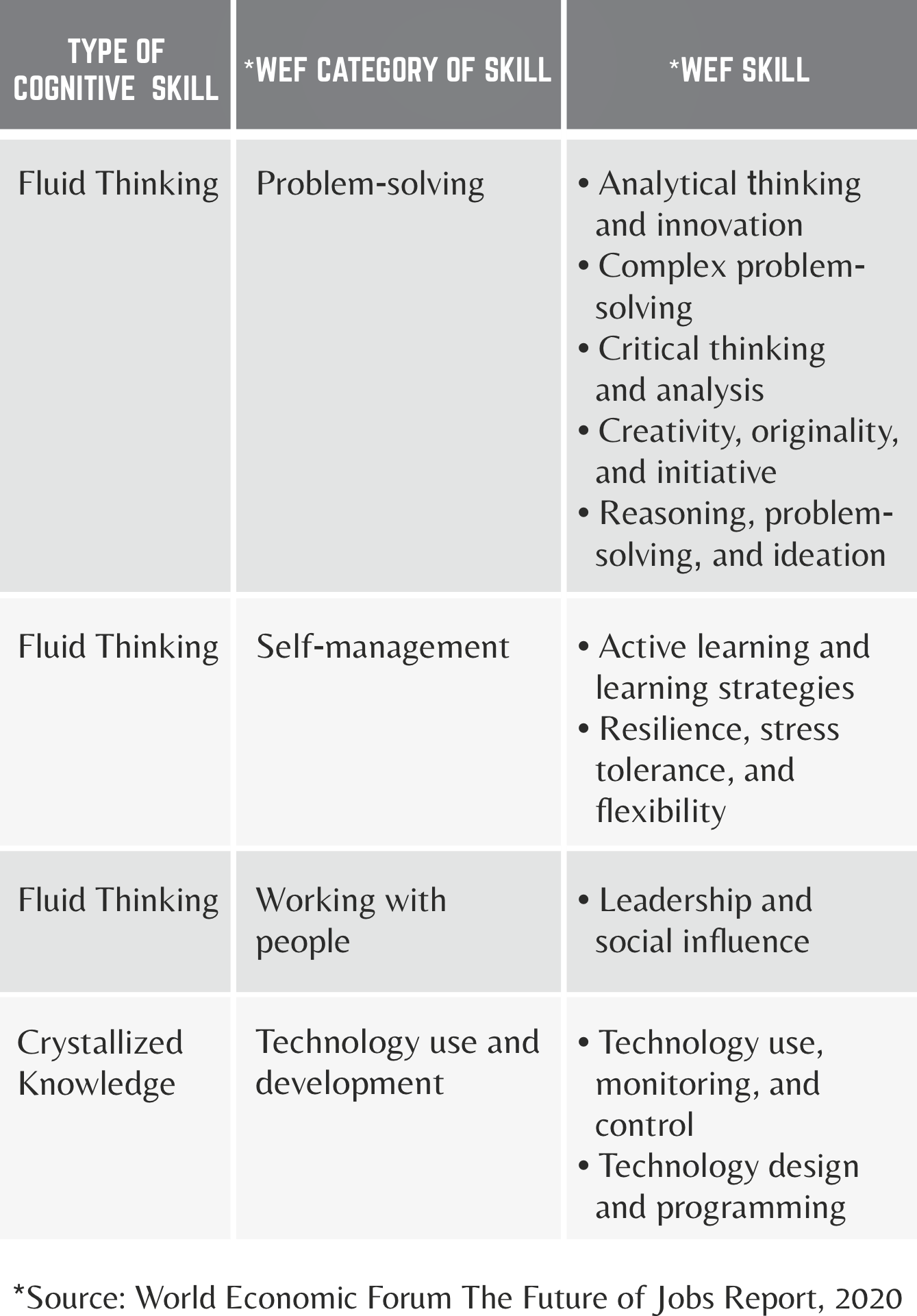
We will all face an enormous challenge as we navigate the need for ongoing reskilling and upskilling. The world is still uncertain about how we will approach these reskilling challenges. This will be a great test of the capacity of CEOs, CFOs and CLOs to adopt a more balanced approach to L&D.
When producing programs oriented toward crystallized knowledge development, the focus is on areas such as the training materials, the associated instructional design and the delivery method. The trainer takes responsibility for the overall training approach.
In contrast, programs oriented toward fluid thinking focus on the learner’s existing agile learning capability and how it can be improved. It is necessary to shift the emphasis from the trainer to the learner.
Achieving success in the future will depend on how we approach developing the brain’s capacity. In the past, there has been an emphasis on “teaching and testing” crystallized knowledge. This will continue to be important, but by itself, is not sufficient for the future outlined by the WEF. It is clear the skills identified by the WEF to equip our employees for the future are predominantly fluid thinking skills and not the traditional crystallized knowledge.
This is further complicated by the rapid advancement of AI because AI platforms will be able to access almost infinite sources of ever-increasing data and information (as opposed to an individual accessing just their own crystallized knowledge). Intriguingly, this will demand enhanced fluid thinking capabilities, such as analytical thinking and conceptual thinking, to develop finely honed questions and context — this will be paramount in extracting the most out of AI platforms.
Part Two: Neuroscience, novelty-routinization theory and its impact on L&D strategies
Elkhonon Goldberg, a clinical professor of neurology at New York University School of Medicine, describes the brain as having two divided and distinct hemispheres that work together, but function and process information in different ways.
According to Goldberg’s novelty-routinization theory about the bicameral brain, the left hemisphere of the brain specializes in processes driven by well-established cognitive routines based on past strategies and experiences. In contrast, the right hemisphere specializes in novel cognitive challenges that cannot be addressed by relying on pre-existing cognitive routines. Thus, cognitive novelty requires an innovative and adaptive approach to thinking, which also plays a particularly important role in the learning process.
Goldberg confirms that the neural pathways that underpin cognitive behavior can change over time. An individual’s mastery of a cognitive task through repeated practice causes change, but it can only happen unidirectionally from the right hemisphere (which specializes in novelty) to the left hemisphere (which specializes in routinization) for most people.
Figure 3 illustrates the functions of the left and right hemispheres based on Goldberg’s novelty-routinization theory. Please note the Corpus Callosum plays a major role in transferring information between the two hemispheres.
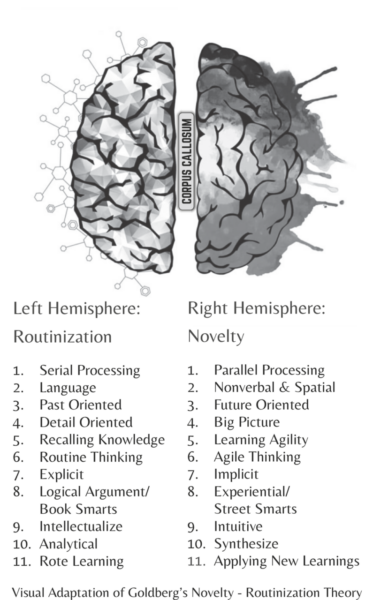
An excellent example of this process is learning to drive a car. Initially, as you begin to orient yourself with everything that driving entails, you rely heavily on the right hemisphere. However, with a lot of practice, you eventually master the skill of driving so well that you can do it without even thinking about it. Indeed, driving becomes a cognitive routine because your brain can easily access this skill routine from the left hemisphere automatically, below the conscious threshold. When you have mastered driving, you can quickly and easily adapt to changes in traffic and weather conditions quickly, even on unfamiliar roads, and control your vehicle with complete ease.
From an L&D perspective, this emphasizes the importance of taking a brain-balanced approach to learning by increasingly tapping into the brain’s right hemisphere novelty functionality rather than an overemphasis on a language-based, left hemisphere routinization functionality.
Many are still trying to train backward because they don’t understand the underpinnings behind brain science. Currently, we try to cram as much language-based information as possible into an individual’s left hemisphere (crystallized knowledge development approach). In so doing, we substantially bypass the right hemisphere, which is used to accelerate the learning process as well as the ability to readily apply new knowledge (fluid thinking development approach).
When an individual’s ability to learn has not been developed optimally, their brain will have difficulty keeping up during the Fourth Industrial Revolution. This will impact the quality and speed of all future learning and the ability to apply those learnings. Relying predominantly on oral and written language for training leaves our left hemisphere overworked and our brain drained, as we are continually asking it to do things it wasn’t designed to do (i.e., cognitive novelty).
Summary, risks and payoff
While it is important to continue to enhance employees’ crystallized knowledge, the WEF is highlighting the need to develop fluid thinking skills due to the Fourth Industrial Revolution.
These skills identified by the WEF include:
- Problem-solving and thinking skills, such as analytical thinking and innovation, critical thinking, reasoning, originality, ideation, etc.
- Self-management skills, such as active learning and learning strategies, resilience, flexibility, etc.
- Working with people skills, such as leadership and social influence.
To enhance employees’ active learning and learning strategies, CLOs and their teams will need to rethink their L&D strategies. This will require a complementary approach to the traditional left hemisphere, language-based crystallized knowledge training. It will also require a new method directed at developing the right hemisphere, nonverbal fluid thinking skills.
To achieve this, organizations will need to tap into the brain’s inherent neuroplasticity to rewire neural pathways and “recode” Subconscious Thinking Habits such as analytical thinking, conceptual thinking, innovative thinking, strategic thinking, abstract thinking, and perspective thinking. A brain balance approach of developing both hemispheres’ capabilities and using Ericsson’s deliberate practice methodology of undertaking and repeating harder and harder cognitive thinking exercises will be essential, as will be applying the enhanced fluid thinking capability to the business world.
As organizations are repositioning themselves through the innovative use of digital technologies and AI, they also need to rethink their L&D strategies and enhance their people’s agile learning capabilities to keep ahead of these ongoing disruptions. This will require a considerable pivot by CLOs and organizations.
By getting this right, organizations can position themselves not only to survive but also to thrive.
The figures presented in this article belong to the author and are provided for illustrative purposes within the context of the content.






